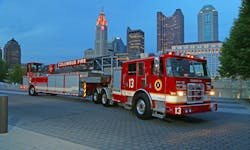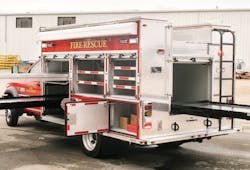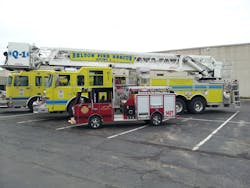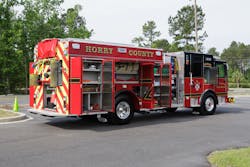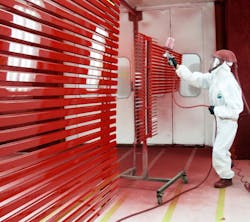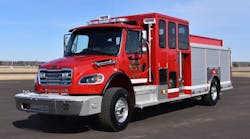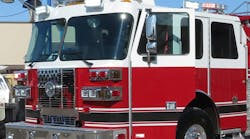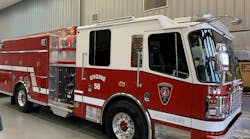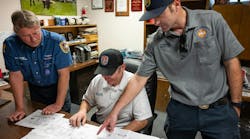Fire apparatus body doors are not the most glamorous part of the rig, but all things considered, they probably experience more wear and tear than any other component.
Firefighters worth their salt never go to a scene without at least one tool in their hand. That means compartment doors are opened on even smells-and-bells calls. At a major event, it’s likely every compartment will be opened on the apparatus, and most likely more than once.
That’s why it’s important to consider what type of door gets specified on your apparatus. Currently, there are two kinds of doors used on apparatus, the traditional formed and welded cabinet doors and a newer, but more dominant style—roll-up doors or shutters.
Each have features and drawbacks that firefighters should understand when considering what kind of cabinet closures best suit their departments’ needs.
Firehouse spoke to several experts in the field, including apparatus builders Boise Mobile Equipment and Pierce Mfg. and door makers Amdor and R•O•M. to learn more about best practices and to hear some pointers on what types of questions should be considered.
Popularity of roll-up doors
Today, about 80 percent of new apparatus have roll-up doors with welded, formed cabinet doors making up only about 20 percent of the market, said John Schultz, the director of Pumper and Chassis Products for Pierce, headquartered in Appleton, WI.
“Right now, the roll-up door seems to be more popular,” Schultz said, noting that many firefighters appreciate the fact roll-up doors don’t protrude from the sides of the apparatus, interfering with side-to-side movement.
On the other hand, formed and welded cabinet doors don’t interfere or intrude into the actual cabinet space itself, providing more room for equipment. Roll-up doors, he said, take up height, reducing some cubic foot space on the apparatus.
Boise Mobile Equipment (BME) an apparatus builder in Boise, ID, with a specialty in wildland apparatus, sells more rigs with form and welded cabinet doors, bucking an industry trend.
Larry Segreto, vice president of BME, said that most of his customers work in very dusty environments and they prefer form welded doors because of the conditions.
“They want doors that work,” Segreto said. “Not to throw stones, but they don’t seem to want roll-up doors.”
Additionally Segreto said BME is “extremely proud” of its doors. He said the company uses aluminum structural tubing for the frame and uses aluminum stress skins on front and back with sheet foam sandwiched between. They also use piano-style hinges with oversized pins to reduce play and wear, Segreto said. “There’s less room for dirt that way,” he added.
As a testimony to the strength of BME doors, Segreto said he once had a customer leave the overhead doors of his apparatus inadvertently open and the doors ended up cutting off five palm trees before being noticed. “Our doors are constructed that heavy,” Segreto said, adding the final door assembly is about two inches thick.
Because of the dusty conditions in which his customers work, BME dovetails the doors into the body and uses a neoprene bulb seal to keep the dust out of the compartments.
“The strength of the door jamb is just as important as the door,” Segreto said. “We want solid framing to the door and we do know that flimsy bodies mean a lot of flex and a lot of popped doors and we don’t want that.”
Schultz said that when roll-up doors were first introduced in the United States, there were some perceived issues with seals and the ability to provide shielding from inclement weather. Today, roll-up doors are widely accepted and, in many cases, are often preferred.
Door variations
“One thing to keep in mind is to make sure you’re getting an apples-to-apples comparison,” Schultz suggested when choosing doors. He said features like opening mechanisms, chains, limiting devices, gas pistons for formed and welded doors and latches can all make a difference when selecting the type of door, whether they’re built by the apparatus manufacturer, or if they’re roll-up doors provided as a part installed on the door.
“It important to understand the differences between brand A and B,” Schultz said. “You’ll want to have an understanding of the manufacturer’s track record. You’ll want to know how to take care of a ding in a door slate, and the after-sales support as well as the warranty.”
Roll-up doors started showing up on apparatus in about 1988, according to R•O•M Corporation, which was at the time located in Kansas City, MO. The company owners, James Pace, and Jack Robinson, owner of JR Industries of the United Kingdom, reached an agreement that R•O•M would build doors in the states and, for 10 years, the product would be called the “R•O•M Robinson Shutter.”
Terry Bay, R•O•M’s applications engineer, said roll-up doors on apparatus have always been popular in Europe because of narrow streets and alleyways on which firefighters worked. The streets were not wide enough for “flaps” or hinged doors. The roll-up door was more or less invented by a fire chief who had experienced a “gull-wing” style door, flipped up over a wheel well, being torn off after accidentally being left up. The roll-up door was the answer to preventing damage to apparatus and station doors.
Bay said roll-up doors continued to be popular even after open-door warning systems were introduced to the fire service. Roll-up doors provide additional firefighter safety in traffic. Bay said firefighters don’t have to peek around an open hinged door to check for traffic.
Another safety feature comes into play when equipment is deployed from cabinets. Roll-up doors provide easy access to all equipment from compartment to compartment without the obstacle of a hinged door, Bay said.
Bruce Whitehouse, president of AMDOR, a roll-up door maker with headquarters in Burlington, Ontario, Canada, and Lancaster, NY, said that despite all the recognized safety benefits, roll-up doors were not an overnight sensation.
“It took a while for manufacturers and fire department personnel to realize the benefits that shutter doors provide,” Whitehouse said.
With vertical openings, responders aren’t forced to stand in traffic lanes to access compartment contents as they are with swing-out doors, Whitehouse said. He added that roll-up doors can be left open, even partially, without fear of having them ripped off by motorists or other means, which is always a risk, especially with high-side compartments.
Since the 1980s when the first roll-up doors were installed on apparatus, Whitehouse said adoption of shutters varies by region and departments.
“Overall, I would say that shutter doors have about 80 percent of the market versus 20 percent for swing doors,” Whitehouse said.
A trend that seems to be gaining popularity are split doors where the bottom half of the door flips down to become an integrated step allowing individuals to gain access to equipment on the top shelves. Schultz said the feature is particularly popular on rescue apparatus and rescue pumpers that Pierce builds.
And that feature can be created with formed and welded cabinet doors as well as roll-up doors apparatus, builders said.
Schultz also said those specifying roll-up doors should carefully look at the quality of doors they select because not all are created equal. Some, Schultz said, flex and are not as strong as others, and each maker has features and qualities that might be better suited for particular departments than others.
Bay said each door manufacturer incorporates various features with specific benefits.
For instance, R•O•M’s Series IV uses a double lip seal between tracks to prevent water and dirt infiltration and a redesigned “D”-shaped lift bar that doesn’t bow or bend. R•O•M also has curved finger pulls with grooved surface for improved grip and extruded inner seals providing improved strength and structural integrity. He added R•O•M also has over-molded idler wheels for the smoothest and quietest operation.
The company also offers a range of options to enhance performance, including door ajar warning switches, compartment lighting, drip pans to keep road debris, snow and rain from falling on equipment in the cabinets, pull ropes and locking mechanism that are also offered as power door locks.
Whitehouse offered some suggestions that fire department personnel should consider when making specifications for new apparatus.
He said, firefighters should look for driven ball-and-socket hinge joints, which is a structural joint allowing rotation between adjacent slats while providing a stronger door curtain. Recessed side seals that have positive contact with the door for full sealing and a non-marring top seal are also important features, Whitehouse said.
Firefighters should also look for interslat seals, which are non-structural and keep moisture and dirt out of the hinge joint and dampen vibration, he said, noting that stainless-steel lift bars provide a rigid latching system that doesn’t flex, meaning that they can be opened with just one hand.
On that same line, Whitehouse said, lift bar strikers that extend on both the top and bottom of the bar to create a positive locking position is a good idea as they will prevent doors from opening during bouncy travel.
Whitehouse also said firefighters should consider dual-color compartment lighting—white for daylight operations and another color, most likely red, for night operations. And when it comes to lighting, all illumination should meet National Fire Protection Association (NFPA) standards and it should be tucked out of the way, while still providing sufficient lighting for users, he said.
Another feature Whitehouse said should be considered is heavy-duty flex pull straps to make it easier to reach up and pull the door down, but not hang below the door so it’s not forgotten and flap around on the outside of the body.
Drip shields not only protect compartment contents from moisture, they also protect the door coil itself from damage that might occur from items inside the cabinets when they are retrieved and returned, Whitehouse said.
If locks are installed, Whitehouse said they should be double-bitted style, like automotive keys which allow them to be inserted either side, adding they should have dust shutters to keep debris and corrosive chemicals from interfering with the lock cylinder operation.
Painted doors
Paint and motorized power drives are other options that can be incorporated on roll-up doors.
When roll-up doors were first introduced, they all had an anodized brushed aluminum appearance and it stayed that way for a number of years, Schultz said.
“That really has changed,” Schultz said, noting that color match paint can be applied to roll-up apparatus doors that can dramatically change the appearance of apparatus.
Whitehouse said the application of wet paint should be applied to the door slats before assembly and should include a multi-stage process with the final application being a clear coat.
“It’s recommended that the top gutter and side frames be left anodized to provide a color break,” Whitehouse said.
Bay said about two-thirds of the doors made by R•O•M are sent out with a satin finish and the remaining are painted at the factory. He said painted doors have up to a seven-year limited warranty, the same for lighting.
For R•O•M, power doors is what sets the company apart from the competition, Bay said. He said R•O•M has a power option that can be built to the same dimensions as the standard Series IV door. He added that the gear motors and electronics for the doors are built in the United States and offer great reliability. The same components can be used for a power hosebed cover, he said.
While the hosebed might not be considered a cabinet in the traditional sense, they do hold equipment that needs to be secured. With a completely enclosed hosebed compartment, the possibility of dragging hose is eliminated, Bay said.
“The [hosebed] door, closed, will support up to 800 pounds and has a NFPA walking surface available as an option,” Bay said.
R•O•M makes shutters big enough for the entire hosebed, up to 90 inches, and makes them as narrow as 15 inches, Bay said, adding that doors can be up to 104 inches tall.
Maintenance
When it comes to maintenance, formed and welded cabinet doors can be washed and cleaned with the remainder of the apparatus. Experts say the hinges should be cleaned and lubricated, as well as the latching mechanisms for proper function.
It’s not much different for roll-up doors.
“Like all equipment, shutter doors require periodic preventive maintenance to ensure they operate effectively,” Whitehouse said.
The routine maintenance on roll-up doors should include the cleaning of the surface with water and a mild detergent to remove debris and road chemicals, Whitehouse said. The tracks should be cleaned with the removal of any dirt and debris, he added, noting that dry lubricant, such as silicone placed on clean cloth and wiped through the entire track section.
“Do not use a lubricant that leaves a residue as this will quickly attract dirt and debris that impede proper door operations,” Whitehouse said.
Whitehouse said the balancer mechanism needs to be checked for proper tensioning periodically as they will weaken over time. If that happens, it will require adjustments to ensure the proper tension.
The recommended level of balancer tension is a “neutral balance,” which means the door can be raised and lowered with “reasonable effort” and will stay in position when released during operations.
Other routine maintenance of roll-up doors should include inspection of the lift bar to make sure it’s engaging and making sure the ajar switches are functioning properly, Whitehouse said, adding that they may need adjustment if they’re not working as designed.
Locks, if so equipped should be exercised to make sure they work when needed most, Whitehouse said, and seals should be checked and replaced if they are torn or damaged.
Bay sums up roll-up door maintenance simply by saying; “If they worked when they were new, they will work when they are clean.” He added they should be washed with “a mild soap and water for continued great performance."
He too recommends silicone spray as the only lubricant for roll-up doors.
Looking to the future
As for the future of apparatus doors, none of the experts believe firefighters in the United States will ever accept fabric-style doors, made of Hypalon or some other flexible fabric as other countries have adopted because they just too flimsy.
There are some thoughts that if the tariffs on aluminum increase too much, there might be a move to fiberglass shutter slats. There’s also a material called pultrusion composite. That is a continuous molding process that uses reinforced fibers saturated in liquid polymer resins and then formed and pulled through a heated die to form a part of particular shapes.
“There are some indications that suggest as aluminum becomes a more expensive commodity, alternative pultrusion composites may see their way into the roll-up door industry,” Bay said.
Whatever the future has in store for apparatus, Whitehouse offered a bit of advice.
“Shutter doors continue to evolve in terms of features and design elements,” Whitehouse said. “When preparing specifications, be sure to check with manufacturers to ensure you have the latest information.”
